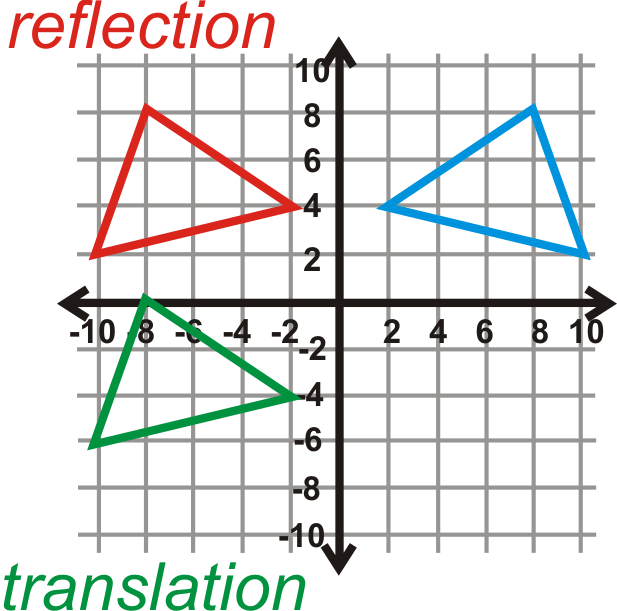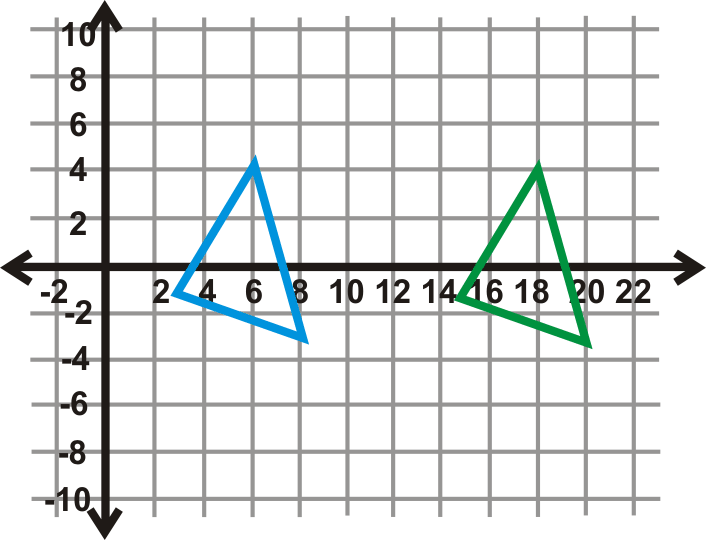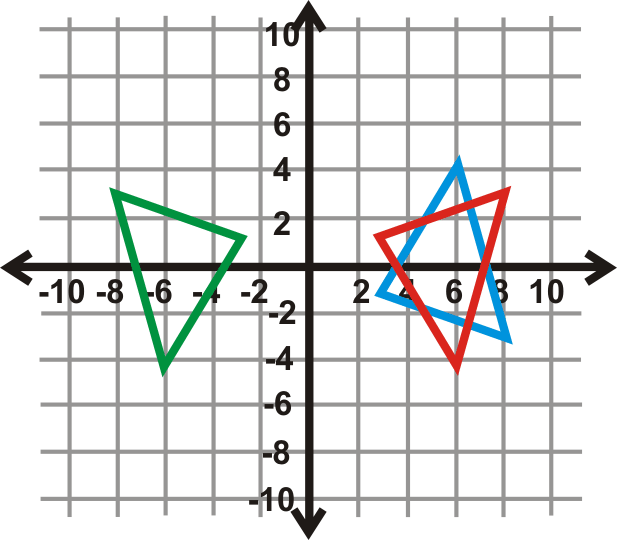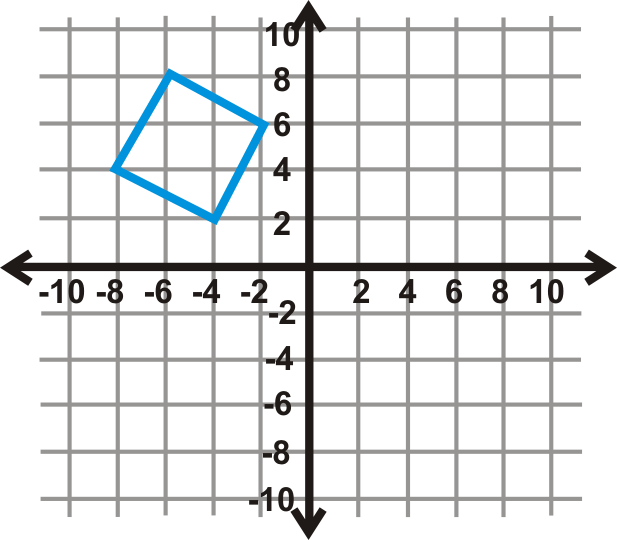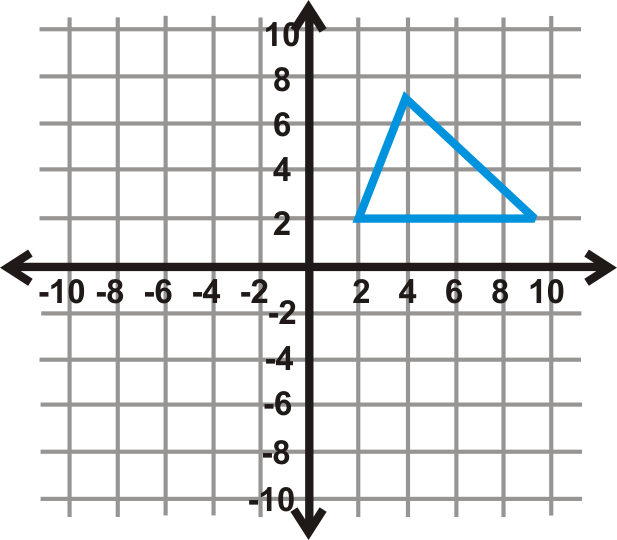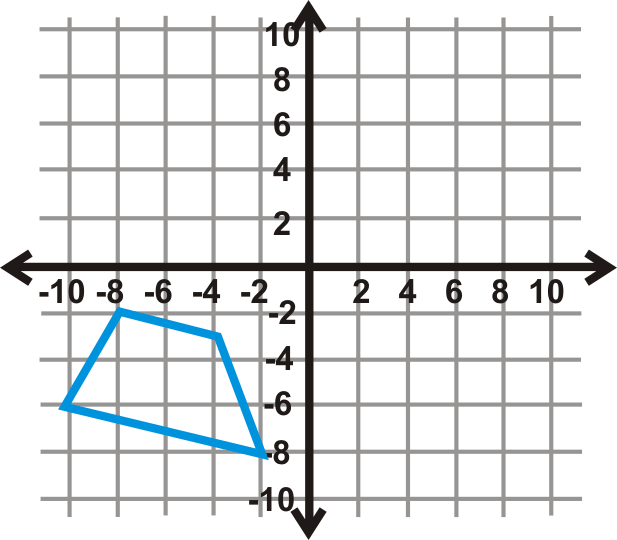12.6 变革的构成
章节大纲
-
Transformations Summary
::转换概要A transformation is an operation that moves, flips, or otherwise changes a figure to create a new figure. A rigid transformation (also known as an isometry or congruence transformation ) is a transformation that does not change the size or shape of a figure. The new figure created by a transformation is called the image . The original figure is called the preimage .
::变换是一种移动、翻转或其他方式改变数字以创建新图的操作。 僵硬变换( 也称为等离线或相容变换) 是一种不会改变图的大小或形状的变换。 变换产生的新图被称为图像。 原图称为预视图。There are three rigid transformations: translations, rotations and reflections . A translation is a transformation that moves every point in a figure the same distance in the same direction. A rotation is a transformation where a figure is turned around a fixed point to create an image. A reflection is a transformation that turns a figure into its mirror image by flipping it over a line .
::有三种僵硬的转换:翻译、旋转和反射。翻译是一个转换,将数字中的每个点都移动在同一方向。一个旋转是一个转换,将数字围绕固定点转换,以创建图像。一个反射是一个转换,通过将图翻到一行,将图转换成镜像图像。Composition of Transformations
::变革的构成A composition (of transformations) is when more than one transformation is performed on a figure. Compositions can always be written as one rule. You can compose any transformations, but here are some of the most common compositions:
::组合( 变换) 是指在图形上进行多个变换时。 组合总是可以作为一条规则写入。 您可以组成任何变换, 但这里有一些最常见的组成 :-
A
glide reflection
is a composition of a reflection and a translation. The translation is in a direction
parallel
to the line of reflection.
::滑翔反射是反射和翻译的构成,翻译的方向与反射线平行。
-
The composition of two reflections over
parallel lines
that are
units apart is the same as a translation of
units (
Reflections over Parallel Lines
Theorem
).
::平行线上两个反射面的构成为 h 个单位,与 2 个单位的翻译相同(平行线理论的反射)。
-
If you compose two reflections over each axis, then the final image is a rotation of
around the
origin
of the original (
Reflection over the Axes Theorem
).
::如果您在每一个轴上进行两个反射, 那么最后的图像将旋转 180\\\\ 围绕原始的起源( 对轴定理的反射) 。
-
A composition of two reflections over lines that intersect at
is the same as a rotation of
. The
center of rotation
is the
point of intersection
of the two lines of reflection (
Reflection over
Intersecting Lines
Theorem
).
::在 x\\\\\\\\\\\\\\\\\\\\\\\\\\\\\\\\\\\\\\\\\\\\\\\\\\\\\\\\\\\\\\\\\\\\\\\\\\\\\\\\\\\\\\\\\\\\\\\\\\\\\\\\\\\\\\\\\\\\\\\\\\\\\\\\\\\\\\\\\\\\\\\\\\\\\\\\\\\\\\\\\\\\\\\\\\\\\\\\\\\\\\\\\\\\\\\\\\\\\\\\\\\\\\\\\\\\\\\\\\\\\\\\\\\\\\\\\\\\\\\\\\\\\\\\\\\\\\\\\\\\\\\\\\\\\\\\\\\\\\\\\\\\\\\\\\\\\\\\\\\\\\\\\\\\\\\\\\\\\\\\\\\\\\\\\\\\\\\\\\\\\\\\\\\\\\\\\\\\\\\\\\\\\\\\\\\\\\\\\\\\\\\\\\\\\\\\\\\\\\\\\\\\\\\\\\\\\\\\\\\\\\\\\\\\\\\\\\\\\\\\\\\\\\\\\\\\\\\\\\\\\\\\\\\\\\\\\\\\\\\\\\\\\\\\\\\\\\\\\\\\\\\\\\\\
What if you were given the coordinates of a quadrilateral and you were asked to reflect the quadrilateral and then translate it? What would its new coordinates be?
::如果你们获得四边形的坐标,然后被要求反映四边形,然后翻译它呢?它的新坐标是什么?Examples
::实例Example 1
::例1Reflect over the axis and then translate the image 8 units down.
::在 y - 轴上反射 ABC, 然后将图像 8 单位翻译下来 。The green image to the left is the final answer.
::左边的绿色图像是最后答案。
:8,8)A(-8,0)B(2,4)B(-2,4)B(-2,4)C(10,2)C(-10,-6)
Example 2
::例2Write a single rule for to from Example 1.
::将“ ABC” 的单一规则写成“ 例1” 中的“A” B” C” 。Looking at the coordinates of to , the value is the opposite sign and the value is . Therefore the rule would be .
::从A到A的坐标看,x值是相反的符号,y值是y-8。 因此,规则是(x,y)%(-x,y-8)。Example 3
::例3Reflect over and then reflect the image over .
::在 y= 3 上反射 ABC, 然后在 y 5 上映图像 。Order matters, so you would reflect over first, (red triangle) then reflect it over (green triangle).
::顺序事项, 所以您会首先反射 Y= 3, (红色三角形) 然后反射 y= 5( 绿色三角形) 。Example 4
::例4A square is reflected over two lines that intersect at a angle . What one transformation will this be the same as?
::方形在以 79 角度相交的两条线上反射。 哪种变形和哪一种变形相同 ?From the Reflection over Intersecting Lines Theorem, this is the same as a rotation of .
::从交叉线理论的反射来看,这与279178的旋转相同。Example 5
::例5has vertices , and . Reflect over and then . Determine which one translation this double reflection would be the same as.
::DEF有D(3)-1,E(8)-3和F(6,4)的顶部,在 x5 上反射 DEF 然后x=1. 确定这种双重反射的翻译与哪一种相同 。From the Reflections over Parallel Lines Theorem, we know that this double reflection is going to be the same as a single translation of or 12 units.
::从平行线理论的反射中,我们知道这种双重反射与2(1至(5)或12个单位的单一译文相同。Example 6
::例6Reflect from Question 2 over the axis, followed by the axis. Find the coordinates of and the one transformation this double reflection is the same as.
::从问题2中反射 X - 轴的 Z- DEF , 后面是 y - 轴。 找到 Q- D 的坐标 。 找到这个双重反射的转换和 y - 轴的坐标相同 。is the green triangle in the graph to the left. If we compare the coordinates of it to , we have:
::“DEF”是图向左的绿色三角形。如果我们将坐标与“DEF”比较,我们就有:
::D(3,-1)-(D)-(D)-(-)-(3,1)-(E)-(8)-(E)-(-8,3)-(E)-(-8,3)-(F)-6,4)-(F)-(-6)-(4)Review
::回顾-
Explain
why the composition of two or more isometries must also be an isometry.
::解释为什么两个或两个以上异类的构成也必须是异度测量。 -
What one transformation is the same as a reflection over two parallel lines?
::一种转变与两种平行线的反射相同吗? -
What one transformation is the same as a reflection over two intersecting lines?
::两种交叉线的反射是相同的?
Use the graph of the square to the left to answer questions 4-6.
::使用左边方形图解答问题4-6。-
Perform a glide reflection over the
axis and to the right 6 units. Write the new coordinates.
::在 x- 轴和右边的 6 个单位上执行滑翔反射。 写入新的坐标 。 -
What is the rule for this glide reflection?
::这种滑翔反射有什么规则? -
What glide reflection would move the image back to the preimage?
::什么样的滑翔反射会让图像回到预映中?
Use the graph of the square to the left to answer questions 7-9.
::使用左边方形图解答问题 7 -9。-
Perform a glide reflection to the right 6 units, then over the
axis. Write the new coordinates.
::向右侧的 6 个单位进行滑翔反射,然后在 x- 轴上方进行。 写入新的坐标 。 -
What is the rule for this glide reflection?
::这种滑翔反射有什么规则? -
Is the rule in #8 different than the rule in #5? Why or why not?
::8中的规则和5中的规则不同吗?
Use the graph of the triangle to the left to answer questions 10-12.
::使用左侧三角形的图解回答问题 10-12 。-
Perform a glide reflection over the
axis and down 5 units. Write the new coordinates.
::在 y- 轴 和 5 个单位上执行滑翔反射。 写入新的坐标 。 -
What is the rule for this glide reflection?
::这种滑翔反射有什么规则? -
What glide reflection would move the image back to the preimage?
::什么样的滑翔反射会让图像回到预映中?
Use the graph of the triangle to the left to answer questions 13-15.
::使用左侧三角形的图解回答问题13-15。-
Reflect the preimage over
followed by
. Write the new coordinates of the reflected image.
::反映 y1 的预映图,然后是 y7 。 写 反映图像的新坐标 。 -
What one transformation is this double reflection the same as?
::这种双重反射与什么变化相同? -
Write the rule.
::写下规则
Use the graph of the triangle to the left to answer questions 16-18.
::使用左侧三角形的图解回答问题16-18。-
Reflect the preimage over
followed
by
. Write the new coordinates of the reflected image.
::映射 y 7 的预景 依次于 y 1 。 写下 反映图像的新坐标 。 -
What one transformation is this double reflection the same as?
::这种双重反射与什么变化相同? -
Write the rule.
::写下规则 -
How do the final triangles in #13 and #16 differ?
::13和16中的最后三角形有何不同?
Use the trapezoid in the graph to the left to answer questions 20-22.
::使用图中左侧的图层图解来回答问题20-22。-
Reflect the preimage over the
axis then the
axis. Write the new coordinates of the reflected image.
::反射 X - 轴的预映像, 然后是 y - 轴。 写入反射图像的新坐标 。 -
Now, start over. Reflect the trapezoid over the
axis then the
axis. Draw this trapezoid.
::现在,从头开始。在 y - 轴上反射捕捉类体,然后是 x - 轴。 绘制这个捕捉类体 。 -
Are the final trapezoids from #20 and #21 different? Why do you think that is?
::20号和21号最后的捕捉类动物有不同吗?
Answer the questions below. Be as specific as you can.
::回答以下问题,尽量具体。-
Two parallel lines are 7 units apart. If you reflect a figure over both how far apart with the preimage and final image be?
::两条平行线是分开的 7 个单位。 如果您能反映一个数字, 显示与预映和最终图像的距离 ? -
After a double reflection over parallel lines, a preimage and its image are 28 units apart. How far apart are the parallel lines?
::在平行线上进行双反射后,预视和图像是28个单位。平行线之间距离有多远? -
Two lines intersect at a
angle. If a figure is reflected over both lines, what is the measure of the angle between the image and the preimage?
::两条线在 165 角度上交叉。 如果一个数字在两条线上反射, 图像和预视之间的角的测量值是多少 ? -
What is the center of rotation for #25?
::25号的旋转中心是什么? -
Two lines intersect at an
angle. If a figure is reflected over both lines, what is the measure of the angle between the image and the preimage?
::两条线在 83 角度上交叉。 如果一个数字在两条线上反射, 图像和预视之间的角的测量值是多少 ? -
A preimage and its image are
apart. If the preimage was reflected over two intersecting lines, at what angle did they intersect?
::预映像及其图像是 244 。 如果预映像在两条交叉线上被反射, 它们从哪个角度交叉 ? -
A preimage and its image are
apart. If the preimage was reflected over two intersecting lines, at what angle did they intersect?
::预映像及其图像是 98\\\\\\\\\\\\\\\\\"98\\\\\\\\\\\\\\\\\\\\\\\\\\\\\\\\\\\\\\\\\\\"\\\\\\\\\\\\\\\\\\\\\\\\\\\\\\\\\\\\\\\\\\\\\\\\\\\\\\\\\\\\\\\\\\\\\\\\\\\\\\\\\\\\\\\\\\\\\\\\\\\\\\\\\\\\\\\\\\\\\\\\\\\\\\\\\\\\\\\\\\\\\\\\\\\\\\\\\\\\\\\\\\\\\\\\\\\\\\\\\\\\\\\\\\\\\\\\\\\\\\\\\\\\\\\\\\\\\\\\\\\\\\\\\\\\\\\\\\\\\\\\\\\\\\\\\\\\\\\\\\\\\\\\\\\\\\\\\\\\\\\\\\\\\\\\\\\\\\\\\\\\\\\\\\\\\\\\\\\\\\\\\\\\\\\\\\\\\\\\\\\\\\\\\\\\\\\\\\\\\\\\\\\\\\\\\\\\\\\\\\\\\\\\\\\\\\\\\\\\\\\\\\\\\\\\\\\\\\\\\\\\\\\\\\\\\\\\\\\\\\ -
After a double reflection over parallel lines, a preimage and its image are 62 units apart. How far apart are the parallel lines?
::在平行线上进行双反射后,预视和图像是62个单位分开的。平行线相距多远?
Review (Answers)
::回顾(答复)Click to see the answer key or go to the Table of Contents and click on the Answer Key under the 'Other Versions' option.
::单击可查看答题键, 或转到目录中, 单击“ 其他版本” 选项下的答题键 。 -
A
glide reflection
is a composition of a reflection and a translation. The translation is in a direction
parallel
to the line of reflection.





